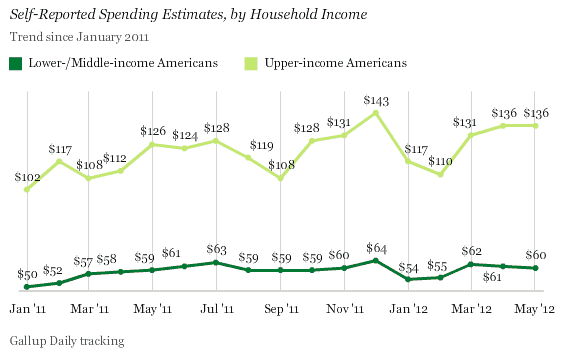WASHINGTON, D.C. -- U.S. consumers' self-reported daily spending averaged $73 in May, holding on to the elevated rate seen in April and May. This marks the third straight month that daily spending has been at least $70, something that has happened only once since the global economic collapse -- during the 2011 holiday season.

The results are based on Gallup Daily tracking interviews with more than 14,500 Americans in May. Gallup asks Americans to report how much they spent the prior day outside of the purchase of a home or motor vehicle, or normal household bills. The figures thus give an estimate of daily discretionary spending.
The current three-month streak comes as Gallup also finds U.S. economic confidence steady at new post-crisis highs. The sustained, elevated level of spending is particularly noteworthy because the only similar post-collapse streak came during the holiday spending season of October-December 2011. Further, the current $73 average is just below the $76 seen last December and higher than the October and November averages.
Additionally, upper-income Americans' self-reported spending has now held above $130 for the third straight month and for the first time since the global economic collapse, including the last holiday season. Lower- and middle-income Americans' self-reported spending has also now posted its best three-month streak since the collapse.

Implications
The current three-month streak of elevated U.S. consumer spending suggests that Americans may be breaking out of the "new normal" spending range triggered by the global economic collapse, in which daily spending typically hovered around $65. A separate Gallup poll conducted in April also found an increasing number of Americans saying they were spending more money than they had in recent months.
It is important to note that Americans' self-reported spending held at the same relatively high rate in March, April, and May, even though gas prices nationwide were higher in April than in March or May. While it is possible that Mother's Day or income tax refunds also played a role in Americans' May spending, Gallup's weekly trends show that spending was actually higher in the latter half of the month than in the first half.
Both the sustained increase in U.S. consumer spending and U.S. economic confidence may now be at risk after Friday's news that the seasonally adjusted U.S. unemployment rate, as measured by the Bureau of Labor Statistics, increased to 8.2% in May. This number is consistent with Gallup's adjusted rate of 8.3% for May, though Gallup's measure reflects a decrease -- rather than an increase -- from the previous month.
It will be important to monitor Gallup's economic trends throughout June to see how Americans react to the most recent jobs report -- and whether it will temper their views of the economy and the day-to-day spending that is critical to a sustained economic recovery.
Gallup.com reports results from these indexes in daily, weekly, and monthly averages and in Gallup.com stories. Complete trend data are always available to view and export in the following charts:
Daily: Employment, Economic Confidence, Job Creation, Consumer Spending
Weekly: Employment, Economic Confidence, Job Creation, Consumer Spending
Read more about Gallup's economic measures.
View our economic release schedule.
Survey Methods
Results are based on telephone interviews conducted as part of Gallup Daily tracking survey May 1-31, 2012, with a random sample of 14,574 adults, aged 18 and older, living in all 50 U.S. states and the District of Columbia.
For results based on the total sample of national adults, one can say with 95% confidence that the maximum margin of sampling error is ±1 percentage points.
The estimates for average daily spending have a margin of sampling error of ±$4.
Interviews are conducted with respondents on landline telephones and cellular phones, with interviews conducted in Spanish for respondents who are primarily Spanish-speaking. Each sample includes a minimum quota of 400 cell phone respondents and 600 landline respondents per 1,000 national adults, with additional minimum quotas among landline respondents by region. Landline telephone numbers are chosen at random among listed telephone numbers. Cell phone numbers are selected using random-digit-dial methods. Landline respondents are chosen at random within each household on the basis of which member had the most recent birthday.
Samples are weighted by gender, age, race, Hispanic ethnicity, education, region, adults in the household, and phone status (cell phone only/landline only/both, cell phone mostly, and having an unlisted landline number). Demographic weighting targets are based on the March 2011 Current Population Survey figures for the aged 18 and older non-institutionalized population living in U.S. telephone households. All reported margins of sampling error include the computed design effects for weighting and sample design.
In addition to sampling error, question wording and practical difficulties in conducting surveys can introduce error or bias into the findings of public opinion polls.
For more details on Gallup's polling methodology, visit www.gallup.com.
